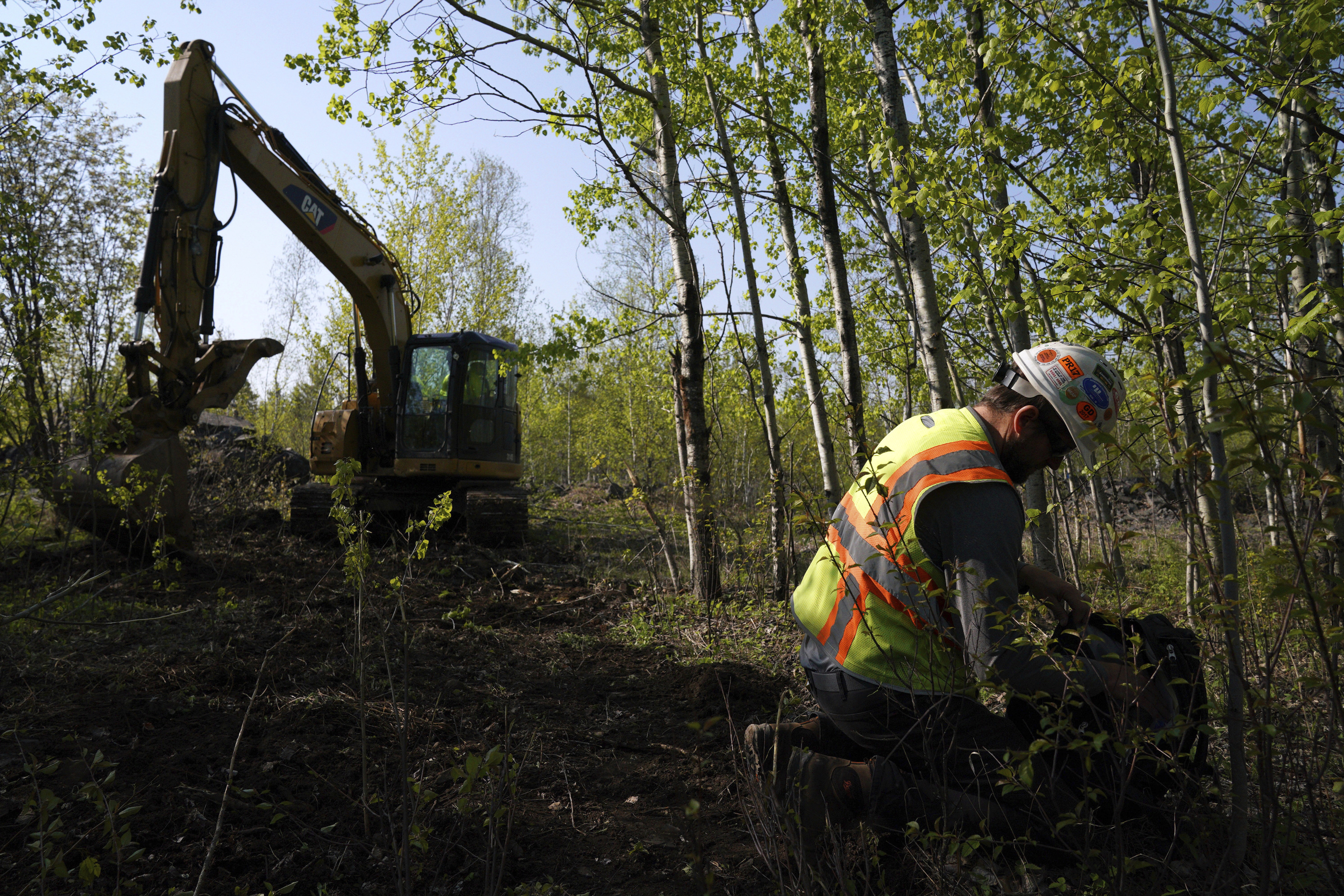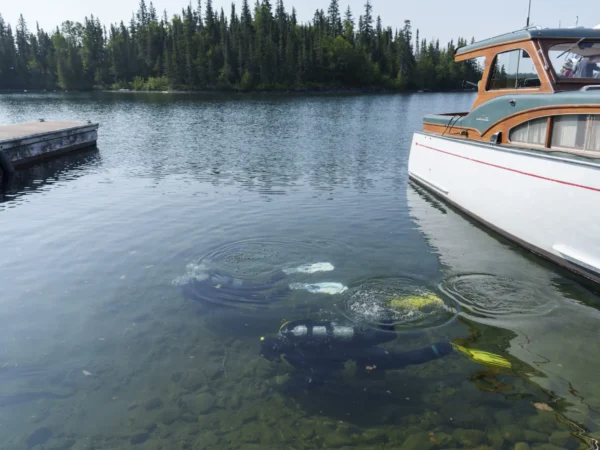
This is the first in a three-part series that will explore the history of Lake Superior and the Boundary waters, the communities affected by two proposed copper mines, the arguments in favor and against the mines, and what the mines might mean for the future of the Great Lakes. Read the second part here and the third part here.
If humans are 70 to 80 percent water, Nancy Schuldt thinks she must be 70 to 80 percent Lake Superior. She fishes in the lake and along the largest river that feeds into it, the St. Louis. She goes ricing in the wetlands all around the watershed. And for more than 20 years now, she’s studied the waterways and worked to protect them as the water projects coordinator for the Fond du Lac Band of Lake Superior Chippewa.

Nancy Schuldt (Photo courtesy of Nancy Schuldt)
“I’ve been on canoes and airboats and kayaks and motorboats on the St. Louis River ever since I came up here to live and work for the band, and I am constantly in awe of how powerful and beautiful it is,” Schuldt said.
But the beauty of both river and lake belie the pollution they’ve been subjected to for the last century. The unique geology of the Upper Midwest that supports such precious freshwater bodies also holds enormous deposits of iron, copper, nickel, gold and platinum.
For more than a decade now, the Fond du Lac, Bois Forte, and Grand Portage Bands, as well as the Great Lakes Indian Fish and Wildlife Commission, and a slew of environmental organizations have grappled with PolyMet and Twin Metals, companies who have proposed building the state’s first ever copper mines. Although Minnesota has a long history with iron ore mines and other forms of resource extraction like logging, opponents of the copper mines say they’ll wreak havoc on the Boundary Waters and Lake Superior watersheds. Those in favor of the mines say they’ll bring much-needed jobs to languishing mining towns, and provide the copper we need to build cars, computers and green infrastructure.
Clean drinking water versus cell phones. Jobs versus health. Resource extraction versus the tourism industry. Can any of them coexist? Those are debates that are still ongoing.
Watch Great Lakes Now‘s segment on Minnesota mining here:
API key not valid. Please pass a valid API key.Iron Beginnings
Lake Superior is the world’s largest lake by surface area, roughly the size of Maine. The standard understanding of the Great Lakes’ formation features the end of the Ice Age and the retreat of glaciers. But Lake Superior’s origin actually stretches back 2 billion years, when an enormous inland depression filled with water. The lake’s shape changed over the millennia, but its longevity and size have made it very cold, very low in productivity and very high in dissolved oxygen. This enormous size is what led miners and city planners to believe any pollution that flowed into the lake would always be overpowered and diluted by the sheer quantity of water.
While Indigenous people took copper from surface outcroppings all around Lake Superior and traded it across the continent, it wasn’t until the 1840s that industrial mining interests came to the region. In Michigan’s Upper Peninsula, it was copper. The Keweenaw Rift jutting up into the middle of Lake Superior is the world’s most important native copper mine and would go on to be exploited for decades. More than 140 copper mines were established by the end of the 19th century, and they left behind millions of tons of waste from the extraction process. Over the years, the lake carried these waste sands across beaches and wetlands, as well as onto the fish spawning grounds along Buffalo Reef.
In Minnesota, early miners went after iron rather than copper. In the mid-1800s, excavations began along the Iron Range, located in the northeastern part of the state. As historian Jeffrey Manuel wrote in “Taconite Dreams: The Struggle to Sustain Mining on Minnesota’s Iron Range,” the region was “considered the richest and most productive iron-ore mining district at the beginning of the century [but] the Iron Range struggled with the challenges of mineral depletion, rising global competition, population loss, and cultural displacement throughout the twentieth century.”
Iron mining in Minnesota and copper mining in Michigan used different technologies and produced different types of pollution. Copper stamp mines crushed the copper out of the surrounding rock and produced massive amounts of sand, or tailings. “Iron waste was less toxic than copper tailings, but the refining process added significant quantities of mercury to the watershed,” environmental historian Nancy Langston wrote in “Sustaining Lake Superior: An Extraordinary Lake in a Changing World.”
The iron ore mines continued operating throughout the 20th century, but the issue of pollution didn’t come to a head until the 1970s. At that point, taconite mines had been running for years, and Minnesota believed the waste material—tailings—couldn’t hurt the environment. The state approved permits for Reserve Mining Company to dispose of their tailings directly into Lake Superior. But after more than a decade of dumping tailings into the lake, scientists discovered the waste contained one of the chemical components of asbestos.
The finding resulted in a lawsuit, the United States of America v. Reserve Mining Company, which dragged on for years. In the end, Reserve Mining was forced to discontinue its practice of dumping tailings into Lake Superior, and taconite mines turned to using ponds for the disposal of tailings.
But even with new regulations, some forms of pollution persisted. A taconite mine near Babbitt, Minnesota, that operated for several decades in the late 1900s has been leaching up to a half a million gallons of contaminated water each month. High sulfate levels in the St. Louis River have reduced the amount of suitable wetland habitat for wild rice, and high mercury levels make fish consumption risky. Today, iron mining is the largest source of mercury emissions in Lake Superior. A 2011 report by the Minnesota Department of Health found that 10 percent of tested newborns in the state had mercury concentrations above safe levels.
Although some iron and taconite mines remain operational in the state, the number of jobs they supply has dropped, and exploratory drilling has shown the tantalizing possibility of unexploited copper and nickel. And with the possibility of this new kind of mine technology came many more questions and concerns.
For Langston, Lake Superior has shown that it’s capable of recovering from pollution, with a lot of work and more stringent regulations. But her concern now is that climate change makes copper mining even riskier than it already would be.
“Climate change is associated with greater total annual precipitation in the basin, greater intensity of storms, greater flooding, greater water level fluctuations, and all these make mine tailings and acid mine drainage much more challenging and expensive to manage effectively,” Langston said by email.
That possibility hasn’t stopped two companies from moving forward with mining proposals and the state permitting process. First came PolyMet, which proposed to renovate and expand an old taconite facility to mine copper near the headwaters of the St. Louis River. More recently, Twin Metals has proposed the creation of an underground copper mine in Superior National Forest, not far from the watershed of the Boundary Waters Wilderness Area.
A mixture of public outcry and support has met both of these projects. For PolyMet, early complaints from environmental groups came on the heels of a land exchange deal from the U.S. Forest Service, when the company was granted land from Superior National Forest. For Twin Metals, an initial sticking point was a federal environmental survey of mining near the Boundary Waters that was initiated by the Obama administration, then canceled upon near completion by the Trump administration. That research has never been released, despite repeated attempts by environmental groups and senators to access the research. The most that has been released to the public at this point are a series of fully redacted pages.
As of June, PolyMet is tangled in litigation around the permits it has received. Twin Metals, which is at an earlier stage of the process, has only recently released its mine proposal. Whether either mine moves forward—and sets a precedent for more copper mines around the region—remains to be seen. But there are plenty of people arguing vociferously for and against both projects.
The next part in the series will look at PolyMet’s proposed mine and the tribal groups fighting against it.
This report was made possible in part by the Fund for Environmental Journalism of the Society of Environmental Journalists. SEJ credits The Hewlett Foundation, The Wilderness Society, The Pew Charitable Trust, and individual donors for supporting this project.
Read more mining coverage from Great Lakes Now:
What are Joe Biden’s views on two of the most controversial environmental projects in Minnesota?
Dependable or Disaster: Safety of Canadian company’s plans for mining in the U.P. under debate
Catch up on more PolyMet news here or Twin Metals news here.
API key not valid. Please pass a valid API key.Featured image: In this May 29, 2019, file photo, Eric Olson, right, gathers his tools as contractor Robert Radotich uses a backhoe to dig areas so the soil stratification can be observed, which will help them engineer and design the infiltration pods for the PolyMet copper-nickel mine in Hoyt Lakes, Minn. (Anthony Souffle/Star Tribune via AP, File)




